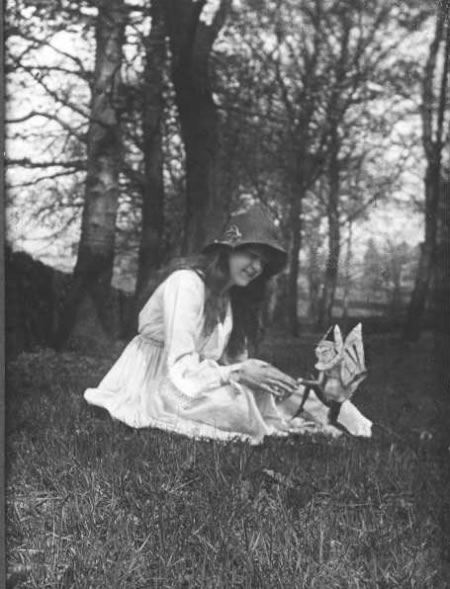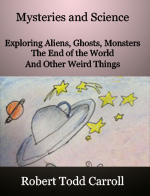From Abracadabra to Zombies
The Cottingley Fairies
In a nutshell: The Cottingley Fairies are paper cutouts of fairies photographed by children and used to trick adults. Some very smart adults believed the photos were of real fairies.
The Cottingley Fairies are paper cutouts of fairies photographed in a garden by two children. Several adults, including Sir Arthur Conan Doyle (the creator of the Sherlock Holmes detective stories), believed they were photos of real fairies.

The photo above was taken by 16-year-old Elsie Wright of her 10-year-old cousin, Frances Griffiths, with Elsie's cutouts of fairies. The location was Cottingley in Yorkshire, England. The year was 1917. The girls made five photos that we know of. Here's one of Elsie with a paper fairy.

It's hard to believe that any adult would think these paper fairies were real, but some did. A man named Geoffrey Hodson came to Cottingley and said he could see the fairies in the garden. Elsie's mother showed the fairy photos to Edward Gardner who printed them in a magazine. Sir Arthur Conan Doyle saw the pictures, looked into the story, and wrote a book about the fairies. Both he and Gardner said that the photos were not of fake fairies. Of course, they didn't see the paper cutouts. They only saw the photos. Experts at the Kodak photographic company said that the photos were real photos but that that didn't prove they were photos of real fairies.
These photos were taken in the days when glass plates were used to capture a negative image that would be transferred to something else like paper. Harold Snelling, an expert on fake photography at the time, examined an original glass plate and said:
This plate is a single exposure. These dancing figures are not made of paper nor any fabric; they are not painted on a photographic background—but what gets me most is that all these figures have moved during the exposure.
I guess Mr. Snelling didn't think that maybe a gentle breeze might have moved the paper cutouts while they were being photographed. Also, Mr. Snelling didn't notice that the waterfall in the background of one of the pictures is blurry. That would tell most experts that the picture was taken at a slow shutter speed. At a slow shutter speed, even with no breeze the paper cutouts might look blurry. Anyway, the fairies were made of cardboard and they were drawn, no matter what Mr. Snelling the expert said.
When older, Elsie and Frances admitted that the photographs were faked using cutouts copied from a popular children's book of the time. Frances, however, always said that their last photograph was real. Here it is:

We don't know why Frances kept up the hoax after her older cousin had told the truth about the photos.
Some adults thought that the photos were not of real fairies but of fairies in the minds of Elsie and Frances. That would have been a great trick: to put your thoughts directly on film just by thinking about it. In fact, some hoaxers have done this trick. They called it thoughtography![]() . There is usually more than one way to do a good magic trick. One way of doing this one is to pretend to take photos with the lens cap on and have already exposed film in the camera. Anyway, Elsie and Frances didn't do this trick. Their hoax was simple and straightforward. They used scissors, pencils, string, and a camera. They proved how easy it is for children to fool grownups. In a television interview in 1985, Frances said: "...it was just Elsie and I having a bit of fun and I can't understand to this day why they were taken in – they wanted to be taken in."
. There is usually more than one way to do a good magic trick. One way of doing this one is to pretend to take photos with the lens cap on and have already exposed film in the camera. Anyway, Elsie and Frances didn't do this trick. Their hoax was simple and straightforward. They used scissors, pencils, string, and a camera. They proved how easy it is for children to fool grownups. In a television interview in 1985, Frances said: "...it was just Elsie and I having a bit of fun and I can't understand to this day why they were taken in – they wanted to be taken in."
These kids soon found out, though, that once grownups have their minds made up about a story you've told, you are probably wasting your time trying to get them to accept the truth. They also found that a bit of fun can follow you around for the rest of your life if you're not careful.
These days with digital cameras and Photoshop all kinds of fake pictures are easy to make.

further reading
Last updated


